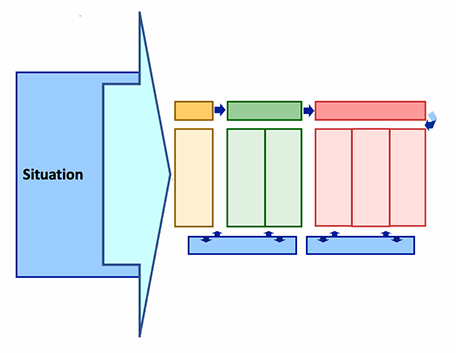Home » Enhancing Program Performance with Logic Models » Section 1: What is a Logic Model? » 1.8: Components of Logic Models – Situation
1.8: Components of Logic Models – Situation

The situation is the foundation for logic model development. The problem or issue that the program is to address sits within a setting or situation – a complex of sociopolitical, environmental, and economic conditions. If you incorrectly understand the situation and misdiagnose the problem, everything that follows is likely to be wrong.
Take time to understand the situation and carefully define the problem. This may be the most important step. As you do so, consider the following questions:
- What is the problem/issue?
- Why is this a problem? (What causes the problem?)
- For whom (individual, household, group, community, society in general) does this problem exist?
- Who has a stake in the problem? (Who cares whether it is resolved or not?)
- What do we know about the problem/issue/people that are involved? What research, experience do we have? What do existing research and experience say?
Often the situation statement is appended to the logic model, as text. We think it is important, however, to include a few words on the far left side of the logic model. These words should capture the core of the originating situation. What is the problem/issue? The situation sets the foundation for everything that follows, and is what we return to in order to see if we are making a difference. Too often we design and implement programs without fully considering and understanding the situation. The better we understand the situation and analyze the problem fully, the easier our logic model development will be.
Questions to Ask During Problem Analysis
- What is the problem?
- Why is this a problem? (What causes the problem?)
- For whom (individual, household, group, community, society in general) does this problem exist?
- Who is involved in the problem?
- Who has a stake in the problem? (Who cares whether it is resolved or not?)
- What do existing research and experience say? What do we know about the problem?
Help with problem analysis
Follow these steps to get to the root cause of the problem:
- State the Issue or Problem
- Ask “Why?”
- For each answer ask, “But, why?” Continue until the “But, why?” questions have been answered.
- For each answer, look at WHO is involved – who is part of the problem and its resolution?
Use the Problem Analysis Table for examples of how to find the root cause of a problem.
Help with understanding your situation
Many Web resources can help with situational analysis. For example, look at the University of Kansas Community toolbox.
Recognizing Assets
Identifying assets is an important part of situational analysis. Valued assets exist within all situations–whether the situation be a community, county, or organization. By recognizing assets, we confirm capabilities, build upon strengths, and empower. Think about existing assets that can be mobilized to support your work.
For help in identifying, mapping, and mobilizing community assets use this resource:
Community Assets.




